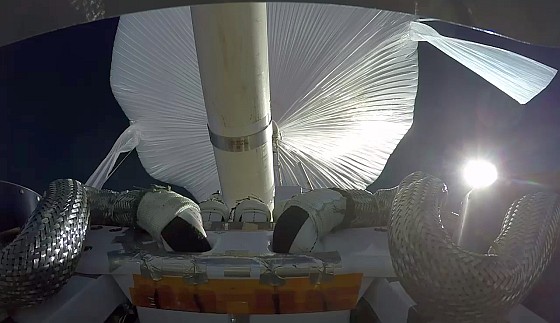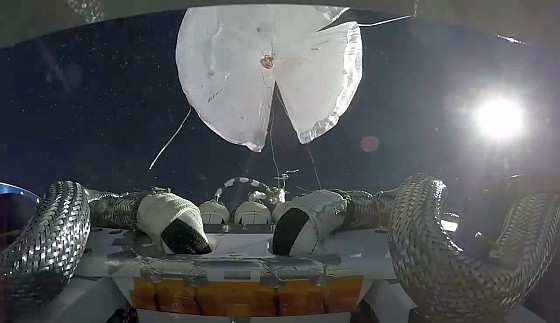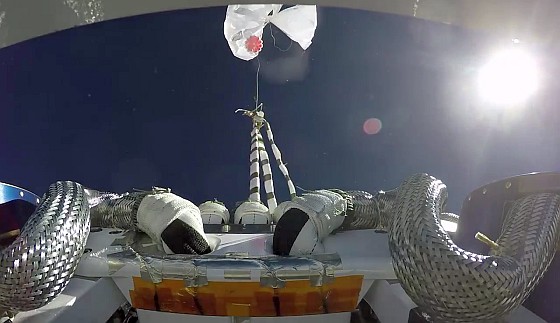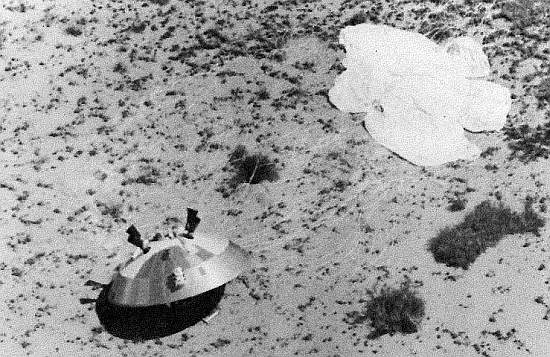News Archive
-
February, 28 2017
Boeing's Starliner descent system tested over White Sands
White Sands, New Mexico.- Spaceport America saw it's first stratospheric balloon launch, a few days ago, as part of the test phase of Boeing's Starliner CST-100 parachute system.
The balloon lifted the flight-sized boilerplate Starliner spacecraft up to about 40,000 feet where it floated across the San Andres Mountains for a parachute landing into the White Sands Missile Range (WSMR). The goal was for the spacecraft to reach the same velocity it would experience during a return from space and for the parachutes to deploy as planned.
Below these lines can be seen the video footage of the test released by Boeing.
The balloon launch took place on a undisclosed date (according to some sources, late February) from Spaceport America's horizontal launch complex. The facility, located in the Jornada del Muerto desert basin lies 20 miles southeast of Truth or Consequences and is the first spaceport which was designed and constructed specifically for commercial users that had not previously been an airport or federal infrastructure of any kind.
As far as I know, this is the first stratospheric balloon mission performed from there.
The vehicle dropped from the balloon was a real-size mockup of the Starliner -also know as a "boilerplate"- and has the same mass, outer mold line, and center of gravity as the real flight vehicle. The nonfunctional craft is used to test various configurations and basic size, load, and handling characteristics of the future manned capsule. Boeing is developing the Starliner to take astronauts to and from the International Space Station in partnership with NASA’s Commercial Crew Program.
Regarding the operations I will make some assumptions from the very little details published about the test, and from what can be seen on the video. The launch was apparently acomplished using the so called "vertical" or "anchor line" method on which the balloon is inflated directly above the payload, but tied to the ground through several anchor cables or ropes that at the moment of release are severed and the balloon/payload set free. One remarkable feature of the launch is that the flight train between the capsule and the balloon was shorter than usual. The reason is the absence of the extended parachute used in the vast majority of scientific missions to allow the safe descent of the payload in case of a catastrophic failure due to the burst of the balloon in flight. In this case, as the objective of the flight was to test the parachute system of the future space capsule being developed by Boeing, it was unnecessary to use it.
The balloon operations were in charge of Army personnel from the White Sands Missile Range, whose vehicles are clearly visible at the start of the video. The balloon, measuring 1.300.000 cubic feet of volume was provided by Near Space Corporation, a private commercial ballooning firm from Tillamook, Oregon.
After release, the ascending balloon took by prevailing winds, moved eastward crossing the San Andres mountain range. 30 minutes after launched while flying at 38.800 ft. it entered over airspace controlled by the White Sands Missile Range where the capsule was released by command, also destroying the balloon as can be seen in the sequence below.



Shortly after the capsule was released from the balloon, two drogue parachutes were deployed at 28,000 feet to stabilize the spacecraft, then its pilot parachutes were released at 12,000 feet. The main parachutes followed at 8,000 feet above the ground prior to the jettison of the spacecraft’s base heat shield at 4,500 feet. Finally, the spacecraft touched the ground lightly, kicking up the desert sand.
Although I've mentioned that this was the first balloon mission to be perfomed from Spaceport America, there was not the first time on which the New Mexican installation name was associated with stratospheric balloons: since 2014 the facility was in the plans of World View, a Tucson based company that will offer in the future balloon rides to near space, which was negotiating the use of the Spaceport to perform their launches. That was, of course, before the company made an agreement with Pima County authorities to built their own balloon launch base outside the Tucson airport.
Also White Sands has a long tradition of involvement in ballooning. Besides a few scientific and military missions performed from it, in fact, the Army range is the favourite place of many agencias to drop or fire things over. Back in late 60's and 70's many model of space probes were droped over White Sands also to test parachute systems, but instead of studying the behaviour of such systems during an earth deorbit, many flight tests used reentry capsules, vehicles and probes that would be used in the atmosphere of other planets.
To simulate the conditions of reentry that the real craft would suffer in its landing in other worlds, the test models were transported by balloon to the stratosphere and once over White Sands were jettisoned in free fall. After an initial phase of free flight, the retrorockets were fired completing the maneuver and acquiring the velocity and attitude of flight to simulate an orbital entry.

Programs like PEPP, Discovery, Galileo or Viking fell into this category. In other cases, the experiments involved the firing of lasers toward the ground from balloons in flight over the range with the purpose to measure atmospheric variables for later analysis. The balloons of these missions were launched from nearby launch sites, specially from the Roswell airport or Holloman AFB.
-
Share this on social media


